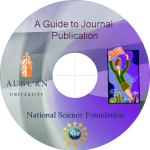

Length and Style
Although there is no standard journal paper length or style, the following is advice provided by journal editors:
- Do not exceed the number of pages or word limits specified by the journal.
- Your chance of getting a paper approved narrows as the length grows beyond 15 pages (note, this is 15 published pages, which is single spaced, TNR or equivalent type and does include all figures, references and tables).
- You should not include paragraphs that are longer than a half page in length, or shorter than three sentences. If a paragraph includes two or more ideas, split them up. Every page should be made up of two or more paragraphs.
- The main body of your paper should be larger than the tables, endnotes, references, and appendix or appendices combined.
- Most journals have a specific format in which the paper should be written. These format guidelines are published in the journal or found on the journal's web site; if not, contact the journal's editor to acquire them. This includes the style of references. References are usually either listed alphabetical (by last name of first author) or in order of citation in the paper. They may be listed numerically or by shortened citation (authors and year of publication). If your paper is not formatted correctly, it may be rejected. If your paper is not in the correct format, this may be a sign to the editor that it has been previously rejected by another journal, or that you have not taken the care to put your paper in the proper format. Note that the format of submission is different from the final print format - while the final print format will be as compact as possible (single spaced with tables and figures within) the format for review will be for the ease of the reviewer (double spaced with tables and figures on separate pages at the end).
- Some journals have guidelines to follow such as maximum length of articles, preferred writing style, length of review time, percent of accepted submissions, and usual length of time between acceptance and publication.
- The style of writing used to generate your paper should follow the style of other papers already published in the journal.
- If your paper uses numerous symbols or notation, including a separate notation section near the beginning of the paper is often useful. In any case, notation or acronyms should always be fully defined the first time they are used in the paper.
- Referees might think it's an entirely descriptive paper if there aren't some equations. On the other hand, if equations dominate your paper, people may lose interest. Try to itemize only the important equations, with the less important equations veiled in the text or included in an appendix.
- Tables are a great way to summarize results and catch the referee's attention. However, there should not be too many entries or numbers in your table. Don't use overly precise entries or entries with different degrees of precision in a single table. Make sure you define units and label tables with meaningful descriptors.
- Pictures are worth a thousand words. Keep figures simple; do not use too many lines, labels, and curves. Remember that while your submission, especially if it is a pdf file, is in color, when printed in the journal, it is apt to be black and white. Therefore, figures should be designed to look right in black and white, unless you especially know the final version will be printed in color (some journals allow color printing but at an extra and significant cost to the author). Also, figures are generally kept small in published papers. Overly complex and cluttered graphs and figures may look fine as a full page but could be a disaster in 1/2 or 1/4 page. Make sure you label figures and include scale and units as needed.
- Do not use too much terminology that is specific to your field. If too much jargon is used, people may lose interest in your paper because the wording is too hard to decipher.
- Do not use too few examples. Because you are the writer and have spent so much time researching the subject of your manuscript, it may be easy to forget the reader may not know as much as you about the subject. Use appropriate descriptions and examples to represent your knowledge in this area, so that the reader may follow the paper and not be left confused.
- Writing in first or third person is often a personal choice, though some journals may dictate third person. Whichever you choose, be consistent. Do not write most of the paper in third person with a few first person sentences. First person tends to be more active and easier to read (and perhaps write) but is considered more informal and can be awkward for a single author (first person single authors tend to use "we" rather than "I").
